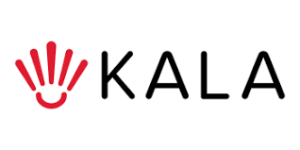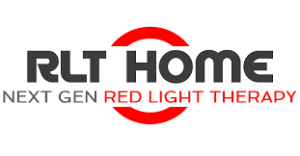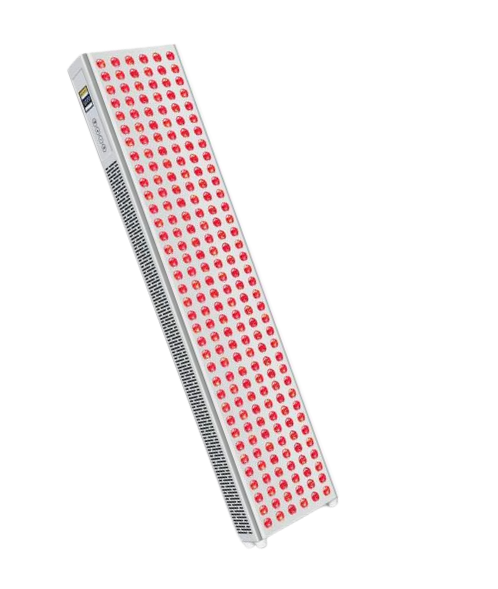
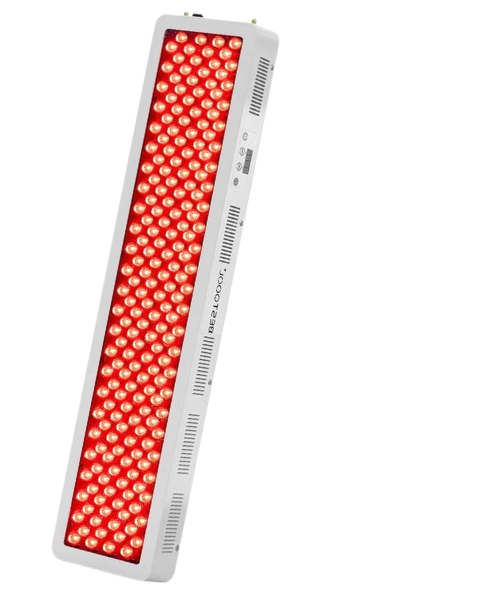
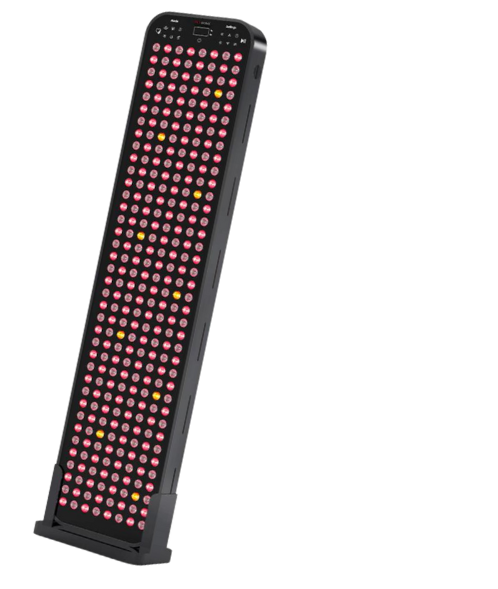
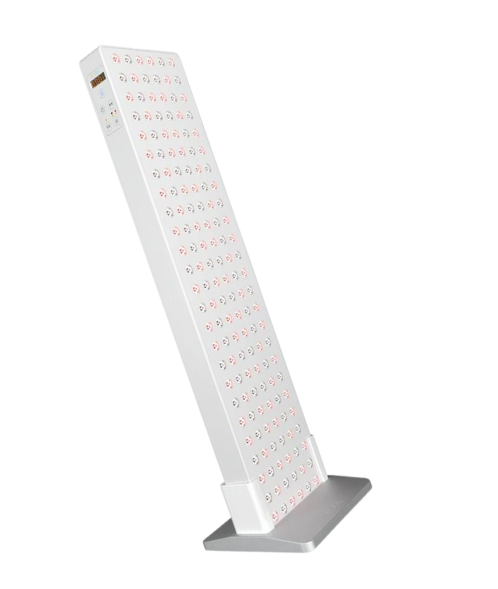
Red Light Therapy
17 Brands Compared
17 Red Light Therapy Panels Ranked on 14 Different Metrics
RLT Ranking Criteria
We compared:
- # of Wavelengths
- Wavelength Densities
- Power Density (Irradiance)
- EMF/Flicker
- Customer Support
- Restocking Fees
- Ease of Returns
- Pre-Built Modes
- Personalized Plans
- Trial Periods
- Warranty
- Build Quality and Looks
- Third Party Reviews
- Hidden Costs
We ranked each company out of a total score of 140 points!
Platinum LED, Mito Red Light, Joovv, Kala, Infraredi, RLT Home, Block Blue Light, Rojo, Rouge, Boncharge, Scienlodic, Red light rising, Hooga, Sunlighten, Lightpath LED, Red Therapy Co & Vital Red Light reviewed to find the best Red Light Therapy device this Black Friday 2025!

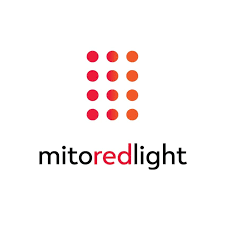




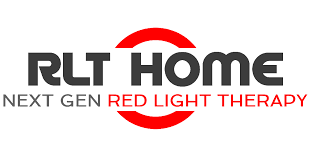
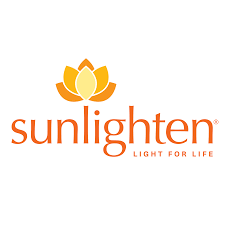

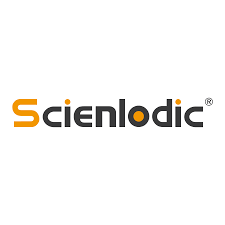






Final Scores and Rankings
Each cell scored out of 10.
| Brand (Sorted Alphabetically) | Wavelengths | Density | Irradiance | EMF | Support | Hidden Fees | Returns | Modes | Personal Plans | Trial period | Warranty | Build Quality | Reviews | Delivery | Score Out of 140 | Rank |
|---|---|---|---|---|---|---|---|---|---|---|---|---|---|---|---|---|
| Blockbluelight | 7 | 4 | 10 | 9 | 6 | 5 | 4 | 9 | 7 | 3 | 10 | 9 | 8 | 6 | 97 | 11 |
| Boncharge | 3 | 4 | 10 | 10 | 5 | 5 | 4 | 6 | 5 | 4 | 4 | 8 | 5 | 6 | 79 | 17 |
| Hooga | 4 | 7 | 9 | 10 | 8 | 9 | 7 | 5 | 6 | 8 | 7 | 8 | 8 | 8 | 104 | 8 |
| Infraredi | 7 | 4 | 9 | 9 | 7 | 9 | 8 | 9 | 7 | 9 | 8 | 8 | 7 | 7 | 108 | 5 |
| Joovv | 3 | 7 | 8 | 4 | 3 | 7 | 5 | 9 | 4 | 7 | 6 | 9 | 4 | 5 | 81 | 16 |
| Kala | 3 | 7 | 10 | 10 | 4 | 1 | 1 | 9 | 7 | 1 | 8 | 9 | 4 | 10 | 84 | 15 |
| Lightpath LED | 7 | 4 | 8 | 9 | 8 | 5 | 5 | 8 | 8 | 6 | 10 | 9 | 8 | 8 | 103 | 9 |
| Mito | 6 | 8 | 10 | 9 | 7 | 9 | 8 | 5 | 6 | 7 | 8 | 8 | 8 | 7 | 106 | 6 |
| Platinum | 9 | 5 | 9 | 10 | 4 | 3 | 4 | 8 | 5 | 6 | 8 | 8 | 5 | 5 | 89 | 13 |
| Red light rising | 7 | 8 | 7 | 10 | 7 | 7 | 6 | 8 | 8 | 8 | 8 | 8 | 7 | 6 | 105 | 7 |
| Red therapy co | 3 | 7 | 8 | 10 | 4 | 7 | 6 | 7 | 5 | 7 | 6 | 8 | 4 | 7 | 89 | 14 |
| RLT Home | 9 | 10 | 10 | 10 | 9 | 10 | 7 | 9 | 9 | 9 | 8 | 9 | 9 | 10 | 128 | 🥇 1 |
| Rojo | 7 | 10 | 8 | 10 | 8 | 8 | 9 | 8 | 9 | 9 | 8 | 9 | 8 | 8 | 119 | 🥈 2 |
| Rouge | 9 | 9 | 8 | 8 | 7 | 9 | 7 | 8 | 7 | 8 | 8 | 8 | 7 | 8 | 111 | 🥉 3 |
| Scienlodic | 7 | 4 | 9 | 10 | 6 | 5 | 6 | 8 | 7 | 8 | 8 | 8 | 7 | 8 | 101 | 10 |
| Sunlighten | 3 | 7 | 6 | 9 | 8 | 5 | 5 | 9 | 8 | 5 | 6 | 9 | 7 | 7 | 94 | 12 |
| Vital Red light | 9 | 3 | 9 | 10 | 9 | 10 | 7 | 8 | 8 | 5 | 8 | 8 | 9 | 7 | 110 | 4 |
Our Picks
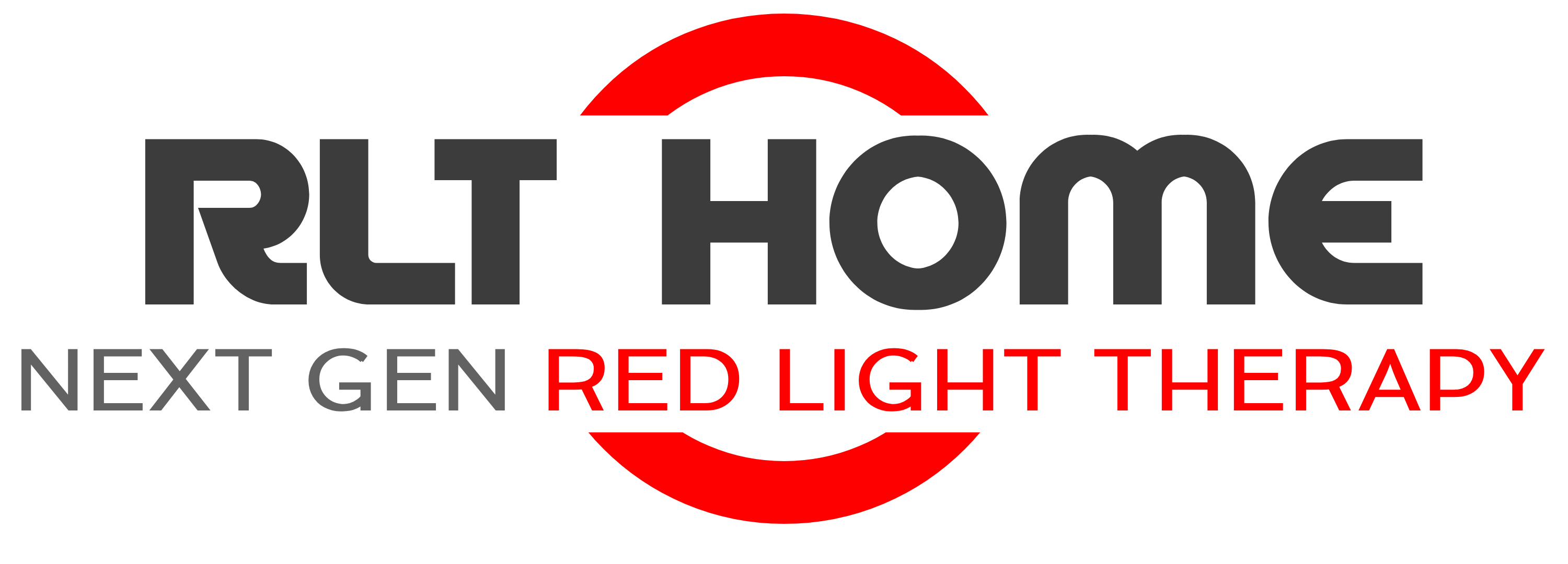
128/140

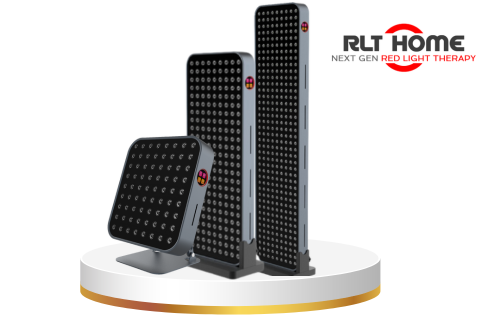
12,300+ Reviews
TotalSpectrum 2.0 Series
- Starting from $495
- Free stand included
- Wavelengths: 7 (480nm, 630nm, 660nm, 810nm, 830nm, 850nm, & 1064nm )
- Irradiance : 172mW/cm2 at 8 inches
- Modes: 7 Pre-Built Science Modes (Full Power, Skin & Anti-Aging, Pain & Inflammation, Sleep, Fat Burn & Weight Loss, Mental Health & Brain)
- Beam Angle: 30 Degrees
- Flicker: Zero
- EMF: 0.0μT
- Touch Screen + Remote
- Aluminium Body
- Cost Per LED: $2-4
- 60-day return policy, no fee
- 3 year warranty
Excels in technical specs (e.g., wavelengths, irradiance, modes), user policies, and reviews, with strong personalization and inclusions. A top performer for at-home red light therapy, especially for those seeking research-aligned versatility and support.
USE EXCLUSIVE CODE “TOP10” for 6% DISCOUNT

89/140

12,300+ Reviews
Biomax Series
- Starting from $459
- Stand not included; separate purchase required.
- Wavelengths: 7 (630nm, 660nm, 810nm, 830nm and 850nm)
- Irradiance: 153mW/cm2 at 12
- Beam Angle: 90 Degrees
- Modes: 1 (Default Mode)
- Beam Angle: 90 Degrees
- Metal Body
- Flicker: Zero
- No EMF Emission 0.0μT
- Cost Per LED: $6-8
- 60-day return policy, restocking fee up to 20%
- 3 Years Warranty
Strong on technical specs (e.g., wavelengths, irradiance, EMF) but weakened by customer service issues, return fees, and mixed reviews.
EXCLUSIVE 5% OFF using our affiliate link below

81/140

12,300+ Reviews
Joovv 3.0 Series
- Starting from $1099
- Stand not included; separate purchase required.
- Wavelengths: 2 (660nm & 850nm)
- Modes: 2 (Default Mode & Recovery Mode)
- Irradiance 100 mW/cm2 (not accurate)
- No Beam Angle Mentioned
- High EMF Emission
- No Flicker
- Plastic Body
- Cost Per LED: $11-18
- 60-day return policy, Customer has to pay shipping cost
- 2 Years Warrant
Strong in features like modes, design, and irradiance, but hampered by EMF, poor support, return hassles, and mixed reviews. Premium pricing suits those valuing app integration.
Use link below

106/140
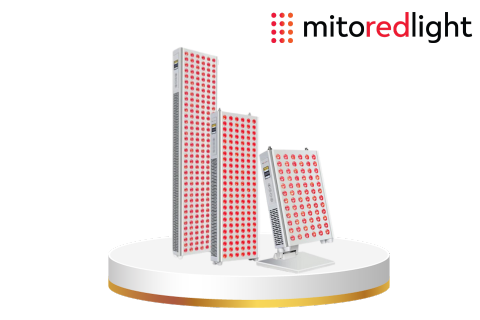
12,300+ Reviews
Mito Pro+ series
- Starting from $369
- Free Stand Included for small device only
- Wavelengths: 4 (630nm, 660nm, 830nm, 850nm)
- Modes: 1 (Default mode)
- Irradiance: 170mW/cm2 at 6”
- Beam Angle: 60 Degrees
- Low EMF
- No Flicker
- Cost Per LED: $4-6
- 60-day return policy, no fee
- 3 Years Warranty
Excels in technical performance (e.g., irradiance, wavelengths) and user policies, with strong reviews offsetting minor drawbacks in modes and personalization.
5% Off using our affiliate link below

104/140
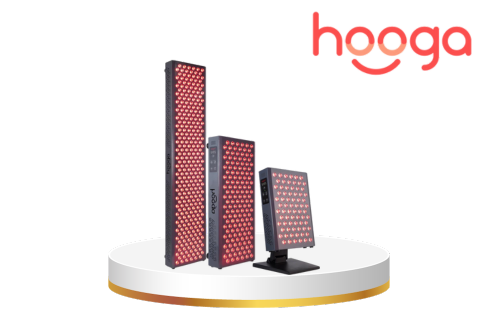
12,300+ Reviews
Hooga Ultra series
- Starting from $426
- Wavelengths: 4 (630nm, 660nm, 810nm 850nm)
- Modes: 1 (Default mode)
- Irradiance: 165mW.cm2 at 6″
- Beam Angle: 60 Degrees
- EMF: Zero at 6 inches
- No Flicker
- Cost Per LED: $4.5-7
- 60-day return policy, no fee
- 3 Years Warranty
Strong value in irradiance, EMF, policies, and affordability, with positive reviews; limited by basic modes, fewer wavelengths, and conditional returns. A budget-friendly option for beginners.
5% OFF on any Product code REDLIGHTTHERAPYTOP10

75/140
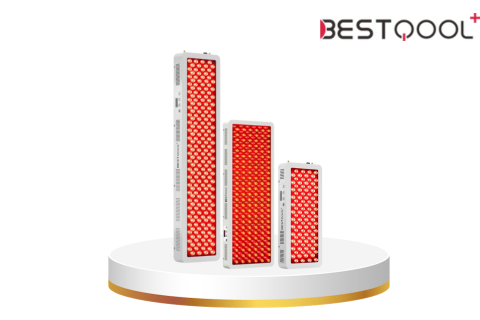
12,300+ Reviews
Bestqool Pro Series
- Starting from $319
- Wavelengths: 2 (660nm & 850nm)
- Modes: 1 (Default mode)
- Irradiance: 124mW.cm2 at 3″
- No Beam Angle Mentioned
- EMF: Low EMF
- No Flicker
- Cost Per LED: $3-3.5
- 30-day return policy, Customer has to pay shipping cost
- 2 Years Warranty
5% OFF
EXCLUSIVE Product code REDLIGHTTHERAPYTOP10
Brand By Brand explanation
Understand our review parameters in depth, for each brand reviewed. Sorted in alphabetical order.
1. Block Blue Light Review
Device Reviewed: Ultimate XXL Red Light Therapy Panel (Full-Body Panel)
- BLACK FRIDAY 2025 – UP TO25% OFF
Based on comprehensive research, the Ultimate XXL is BlockBlueLight’s flagship full-body red light therapy panel. It measures approximately 72” x 24” (based on LED count and comparisons), features 1200 x 5W dual-chip LEDs for massive coverage, and is designed for whole-body treatments with advanced multi-wave technology. Here’s a detailed scoring on each criterion, out of 10, with supporting rationale. Scores reflect performance relative to industry standards (e.g., competitors like PlatinumLED, Mito Red, Joovv, Kala, Infraredi, or RLT Home), where higher is better for user-friendly or beneficial features (e.g., low EMF, no extra costs). The overall score is the sum out of 140.
- Number of Wavelengths: 7/10 Features 5 wavelengths (630nm, 660nm red; 810nm, 830nm, 850nm NIR) for balanced skin, inflammation, and deep-tissue benefits. Solid but fewer than top models with 7+.
- Percentage of Each Wavelength: 4/10 No exact percentages or ratios disclosed; described as an optimized blend without transparency.
- Irradiance: 10/10 High output: 189 mW/cm² at 6 inches (solar meter), 90 mW/cm² average (spectrometer), supporting efficient full-body sessions.
- EMF: 9/10 Ultra-low EMF at treatment distances, with safety emphasis; not quantified but competitive with near-zero options.
- Customer Support: 6/10 Mixed: Praised for responsiveness and helpfulness in some cases (e.g., free replacements), but frequent complaints of delays (up to 9 days), poor communication, and unprofessional handling.
- Restocking Fees: 5/10 Not explicitly stated, but exchanges incur costs (e.g., losing sale prices, additional shipping); no clear zero-fee policy, unlike better competitors.
- Ease of Returns: 4/10 Process involves email/contact, but reviews highlight hassles like buyer-paid shipping, delays, and denials for damaged items; no straightforward policy for panels.
- Pre-Built Modes: 9/10 Includes dimming (1-100%), pulsing (1-10,000Hz), and 4 savable custom presets for intensity, wavelengths, duration, and pulse; touchscreen for easy setup.
- Help with Personalized Use: 7/10 Touchscreen customization, detailed user manual, and blog guides available; no app or dedicated coaching, but sufficient for basic tailoring.
- Trial Period: 3/10 Not advertised; general returns window implied as short (e.g., 30 days inferred from complaints), with conditions reducing usability.
- Warranty: 10/10 5 years standard, covering defects and emphasizing durability; among the longest in the industry.
- Looks of the Panel: 9/10 Premium, well-made design with touchscreen; described as “beautiful” and “amazingly well made,” suitable for home or professional use.
- Customer Reviews on Third-Party Platforms: 8/10 Trustpilot 4.5/5 (850+ reviews) and Reddit mostly positive for effectiveness (e.g., sleep, energy, skin), quality, and value; negatives on service and shipping.
- Good Example: “Great glasses, excellent service. The glasses do what they say. They are RED. So they actually block bluelight. Any glasses that claim to block bluelight and arent red is a rip off. The glasses are stylish and they have many frames available. They actually look good. Like you could wear them out. Recently they have made some updated to the frame. When I bought 2 pairs a year ago the frame cracked with very little wear. And while the glasses are relatively affordable for custom reading glasses i was pretty disappointed they only lasted a short while. But when I emailed support about this, they responded by saying they were aware of this issue and had since updated the design and sent me a free replacement! I really appreciate that. The new design is really sturdy and quality. Overall, the glasses are great and the customer service is excellent. You can trust this company with your money.”
- Bad Example: “Hey everyone I placed an order on Dec 30. (red light panel, floor stand, blue blocking glasses) On Jan 3rd they said the items will ship shortly and I will receive a email notifying me when it leaves the California location. 10 days later after I reached out they sent an email stating the floor stand is on pre order and has an expected delivery date of January 31. After annoyingly communicating with them answering every 4 days they told me for $4.95 they could ship part of the order. I said sure and haven’t heard back for 9 days. I don’t understand why I have to wait a month, why their customer service is so bad, why they can’t ship part of the order.”
- Extra Costs for Stand/Insured Delivery: 6/10 Stands/mounts are add-ons (e.g., motorized stand upcoming, ~$200+ estimated from similar); free shipping on orders over certain thresholds in some regions, but international duties/fees and insured options not standard/free; delays noted.
Overall Score: 91/140
Strong in technical performance (e.g., irradiance, modes, warranty) and design, but weakened by opaque policies, mixed support/reviews, and return/shipping issues. A solid choice for power-focused users, but consider alternatives for better service and flexibility.
2. Boncharge Review
Device Reviewed: Super Max Red Light Therapy Device (Full-Body Panel)
- BLACK FRIDAY 2025 – UP TO 25% OFF
Based on comprehensive research, the Super Max is Bon Charge’s flagship full-body red light therapy panel. It measures 35.5” x 11.8” x 2.56”, weighs 31 lbs, and features 300 LEDs for extensive coverage, with options for door mounting or pulley setup. Here’s a detailed scoring on each criterion, out of 10, with supporting rationale. Scores reflect performance relative to industry standards (e.g., competitors like PlatinumLED, Mito Red, or Joovv), where higher is better for user-friendly or beneficial features (e.g., low EMF, no extra costs). The overall score is the sum out of 140.
- Number of Wavelengths: 3/10 Features 2 wavelengths (660nm red, 850nm NIR) for basic skin and tissue benefits, lacking broader options like 630nm or 810nm.
- Percentage of Each Wavelength: 4/10 No exact percentages or ratios disclosed; described as a blend without transparency.
- Irradiance: 10/10 – 162 mW/cm², enabling efficient full-body sessions; among the higher outputs tested.
- EMF: 10/10 Ultra-low at 0.1-0.05 µT, with flicker-free design for safety.
- Customer Support: 5/10 Mixed: Some praise responsiveness and resolutions, but prevalent complaints of delays, unhelpfulness, and lack of replies (e.g., for faults or queries).
- Restocking Fees: 5/10 15% fee for non-faulty returns; higher for refused packages, and sales items ineligible for refunds.
- Ease of Returns: 4/10 30-day window via returns center, but buyer pays shipping (expensive internationally), strict new-condition requirements, and no refunds for sales/BOGO items.
- Pre-Built Modes: 6/10 Basic options: red-only, NIR-only, or combined; built-in timer up to 20 minutes, but no advanced presets or pulsing.
- Help with Personalized Use: 5/10 Product comparison table and general home-use guidance; no apps, coaching, or tailored protocols.
- Trial Period: 4/10 30 days implied via returns, but hampered by fees, shipping costs, and restrictions (e.g., no refunds on sales).
- Warranty: 4/10 1 year standard; shorter than competitors’ 3-5 years.
- Looks of the Panel: 8/10 Premium build with durable design, easy setup via door mount/pulley; described as high-quality and professional.
- Customer Reviews on Third-Party Platforms: 5/10 Polarized across Trustpilot (~3.5/5 average), Reddit, and forums: positives on effectiveness (e.g., energy, skin, recovery); heavy criticism for service, returns, durability, and overseas issues.
- Good Example: “Fantastic Product! … It takes my life and energy levels to a whole new level. I’m grateful!”
- Bad Example: “Bon Charge is a crap company with crap policies. They’re also located in Australia so shipping can be a problem.”
- Extra Costs for Stand/Insured Delivery: 6/10 No stand available (door mount included); shipping calculated at checkout (free over thresholds in some regions), but international duties and delays common.
Overall Score: 79/140
Strong in core specs like irradiance and EMF, but undermined by short warranty, restrictive policies, mixed support/reviews, and limited features. Effective for basic full-body use, but consider alternatives for better service and flexibility.
3. Hooga Review
Device Reviewed: HGPRO1500 (Full-Body Panel)
- BLACK FRIDAY 2025 – UP TO 25% OFF
Based on comprehensive research, the HGPRO1500 is Hooga’s flagship full-body red light therapy panel. It measures 36” x 12” x 3”, features 300 dual-chip LEDs, consumes 500W, and is designed for whole-body treatments with modular connectivity and a built-in stand. Here’s a detailed scoring on each criterion, out of 10, with supporting rationale. Scores reflect performance relative to industry standards (e.g., competitors like Mito Red or PlatinumLED), where higher is better for user-friendly or beneficial features (e.g., low EMF, no extra costs). The overall score is the sum out of 140.
- Number of Wavelengths: 4/10 Features 2 wavelengths (660nm red, 850nm NIR) for basic skin and tissue benefits; lacks broader options like 630nm or 810nm in premium models.
- Percentage of Each Wavelength: 7/10 Even 50/50 split between red and NIR, with mode selection for individual or combined use; transparent but not customizable percentages.
- Irradiance: 9/10 High output: >115 mW/cm² at 6 inches, enabling efficient sessions; independent tests confirm strong performance.
- EMF: 10/10 0.0 µT at 6 inches, with independent verification for zero emissions at treatment distances.
- Customer Support: 8/10 Responsive via email/phone, with positive feedback on helpfulness and resolutions; some delays noted but overall strong.
- Restocking Fees: 9/10 None mentioned in policies; partial refunds only if not original condition, better than competitors with flat fees.
- Ease of Returns: 7/10 60-day window, but buyer pays shipping, requires original packaging/like-new condition; straightforward but not free.
- Pre-Built Modes: 5/10 Basic selection: red-only, NIR-only, or combined; built-in timer (up to 20 min), but no advanced presets or pulsing.
- Help with Personalized Use: 6/10 User manual with dosing guides and mode options; limited to general advice, no app or coaching.
- Trial Period: 8/10 60 days risk-free, with full refund if conditions met; generous but buyer-paid return shipping.
- Warranty: 7/10 2-3 years (varies by source), covering defects; solid but shorter than 5-year options from peers.
- Looks of the Panel: 8/10 Sturdy build with built-in stand, cooling fans, and professional design; praised as affordable and easy to use.
- Customer Reviews on Third-Party Platforms: 8/10 Positive across Reddit (e.g., skin/energy improvements) and Trustpilot (~4.5/5 inferred from site feedback); some negatives on limited results or shipping.
- Good Example: “I love my full body device from Hooga, the HG1500. I use it every day… I feel energized… my skin looks great.”
- Bad Example: “While I will acknowledge that it is clearly more powerful, I haven’t noticed any material changes in effectiveness in the few weeks I’ve had it.”
- Extra Costs for Stand/Insured Delivery: 8/10 Free U.S. shipping; built-in stand included, but mobile stands/wheels are add-ons (~$50-200); no insured fees standard.
Overall Score: 104/140
Strong value in irradiance, EMF, policies, and affordability, with positive reviews; limited by basic modes, fewer wavelengths, and conditional returns. A budget-friendly full-body option for beginners, but alternatives may suit advanced needs better.
4. Joovv Review
Device Reviewed: Quad 3.0 (Full-Body Panel)
- BLACK FRIDAY 2025 – UP TO $1000 OFF
Based on comprehensive research, the Quad 3.0 is Joovv’s flagship full-body red light therapy setup, consisting of four modular Solo 3.0 panels (each ~36” x 9” x 3”, combined for ~72” height coverage). It supports whole-body treatments with app control, pulsing, and high build quality. Here’s a detailed scoring on each criterion, out of 10, with supporting rationale. Scores reflect performance relative to industry standards (e.g., competitors like PlatinumLED or Mito Red), where higher is better for user-friendly or beneficial features (e.g., low EMF, no extra costs). The overall score is the sum out of 140.
- Number of Wavelengths: 3/10 Limited to 2 wavelengths (660nm red, 850nm NIR) for basic skin and tissue benefits, lacking broader multi-wave options (e.g., no 630nm or 810nm).
- Percentage of Each Wavelength: 7/10 Even 50/50 split between red and NIR, with clear mode selection (red-only, NIR-only, or combined), providing good transparency and control.
- Irradiance: 8/10 Solid output: ~60-70 mW/cm² at 6 inches in combined mode, enabling effective sessions; third-party tests confirm reliable power, though not the absolute highest.
- EMF: 4/10 Emits noticeable levels, especially electric fields at close range; meets basic safety standards but higher than competitors with near-zero readings.
- Customer Support: 3/10 Options include a support form and knowledge base, but reviews frequently cite unresponsiveness, poor resolution, and attitude issues; no phone support.
- Restocking Fees: 7/10 No fees for modular devices like the Quad if returned unopened/like-new; however, $50 applies to smaller Go models, and reviews mention hidden penalties.
- Ease of Returns: 5/10 60-day window for modular setups, but buyer pays return shipping, requires original packaging/like-new condition, and international returns face deductions/delays.
- Pre-Built Modes: 9/10 Advanced app integration with presets like Recovery+ (pulsing), ambient mode, and customizable timers/wavelengths; among the best for user-friendly operation.
- Help with Personalized Use: 4/10 Basic guides and app tips available, but limited proactive coaching or tailored protocols; support focuses on general queries rather than customization.
- Trial Period: 7/10 60 days for the Quad, starting from delivery; conditional on condition and shipping, but longer than some competitors’ 30-45 days.
- Warranty: 6/10 2 years standard on modular devices, with FDA Class II clearance; reliable but shorter than the 3-5 years offered by peers.
- Looks of the Panel: 9/10 Premium, sleek modular design with a modern aesthetic, easy stacking, and high-end build; praised as professional and durable.
- Customer Reviews on Third-Party Platforms: 4/10 Polarized across Trustpilot (~3/5 average), Reddit, and BBB: positives on effectiveness, but heavy criticism for service, returns, and value.
- Good Example: “I’ve noticed significant improvement in skin health, muscle & joint recovery… and improved mood during winter months.”
- Bad Example: “Terrible C/S and lots of attitude. No number to call, only Chat or email. If they don’t like what you type…”
- Extra Costs for Stand/Insured Delivery: 5/10 U.S. shipping free on orders over $500, but stands/mounts are add-ons (~$200+); international incurs duties/fees, and no standard insured delivery.
Overall Score: 81/140
Strong in features like modes, design, and irradiance, but hampered by high EMF, poor support, return hassles, and mixed reviews. Premium pricing suits those valuing app integration, but alternatives may offer better value and policies for full-body use.
5. Kala Therapy Review
Device Reviewed: Quad Panel (Full-Body Panel)
- BLACK FRIDAY 2025 – UP TO 20% OFF
Based on comprehensive research, the Quad Panel is Kala’s flagship full-body red light therapy device, featuring 924 LEDs across four modular panels for extensive coverage (70” x 16” x 2.5”). It is positioned as a commercial-grade option for whole-body treatments, with FDA Class II clearance and customizable features. Here’s a detailed scoring on each criterion, out of 10, with supporting rationale. Scores reflect performance relative to industry standards (e.g., competitors like PlatinumLED, Mito Red, or Joovv), where higher is better for user-friendly or beneficial features (e.g., low EMF, no extra costs). The overall score is the sum out of 140.
- Number of Wavelengths: 3/10 Limited to 2 wavelengths (660nm red, 850nm NIR) for standard skin and tissue benefits, without broader options like 630nm or 810nm.
- Percentage of Each Wavelength: 7/10 Balanced 50/50 ratio (1:1) between red and NIR, with transparency and mode selection for individual or combined use.
- Irradiance: 10/10 High output of 161 mW/cm² at 6 inches, supporting efficient, deep-penetrating sessions; among the top in tested power.
- EMF: 10/10 0.00 µT at 4 inches, with zero emissions emphasized for safety at treatment distances.
- Customer Support: 4/10 Some praise for responsiveness and client focus, but frequent complaints about delays, unresponsiveness, and poor resolution in reviews.
- Restocking Fees: 1/10 $15 fee for eligible products, but the Quad is final sale with no returns allowed, making fees irrelevant and user-unfriendly.
- Ease of Returns: 1/10 30-day window for some products, but Quad is explicitly final sale/no returns; requires email initiation, and reviews cite denials or hassles.
- Pre-Built Modes: 9/10 Includes 7 custom frequencies, Pulse Recovery+ mode, and timer presets (10/20/30 min) with remote control for versatile sessions.
- Help with Personalized Use: 7/10 Remote customization, user manual, and device quiz for selection; some expert consultations mentioned, but limited bespoke protocols.
- Trial Period: 1/10 No trial for Quad (final sale); general 30-day guarantee for others is shortened by conditions and fees, with complaints of enforcement issues.
- Warranty: 8/10 3 years standard, with 50,000-hour lifespan and rigorous testing; solid coverage but not the longest available.
- Looks of the Panel: 9/10 Premium iron construction, flicker-free LEDs, silk display, and quiet fan; described as durable, professional-grade, and built to last.
- Customer Reviews on Third-Party Platforms: 4/10 Highly mixed on Reddit and Trustpilot proxies; positives on effectiveness, but prevalent negatives on service, shipping, and ethics (e.g., scam accusations). No direct Trustpilot page, but aggregated feedback averages low.
- Good Example: “I have ordered multiple devices from Kala Therapy and their devices are much superior than JOOVV, MITO, ETC.. I had the best experience with Kala’s support team as well.”
- Bad Example: “Absolutely a scam. I would not deal with this company again.”
- Extra Costs for Stand/Insured Delivery: 10/10 Free shipping in Canada/USA; vertical stand included with no add-ons required; no insured delivery fees mentioned.
Overall Score: 83/140
Strong technical specs (e.g., irradiance, EMF, modes) and inclusions like free stand/shipping, but severely undermined by no-returns policy, poor support reviews, and short/no trial for the Quad. Suitable for committed users prioritizing power, but alternatives may better suit those needing flexibility or reliable service.
6. Light Path Review
Device Reviewed: Diesel XL (Full-Body Panel)
- BLACK FRIDAY 2025 – UP TO 30% OFF
Based on comprehensive research, the Diesel XL is LightpathLED’s flagship full-body red light therapy panel. It measures ~70” x 24” (modular for expansion), features 304 dual-chip LEDs, and is designed for whole-body treatments with pulsing options, multi-wavelengths, and iron casing for durability. Here’s a detailed scoring on each criterion, out of 10, with supporting rationale. Scores reflect performance relative to industry standards (e.g., competitors like Mito Red or PlatinumLED), where higher is better for user-friendly or beneficial features (e.g., low EMF, no extra costs). The overall score is the sum out of 140.
- Number of Wavelengths: 7/10 Features 5 wavelengths (620nm, 660nm red; 810nm, 850nm, 930nm NIR) for balanced skin, muscle, and deep-tissue benefits. Solid but fewer than leaders with 7+.
- Percentage of Each Wavelength: 4/10 No exact percentages or ratios disclosed; described as an optimized blend without granular details. Lacks transparency compared to brands that publish breakdowns.
- Irradiance: 8/10 80 mW/cm² at 3 inches, enabling effective sessions; competitive but not the highest in third-party tests.
- EMF: 9/10 0 µT at 3 inches, with emphasis on safety; minor readings (0.28 µT at 6 inches) in some tests but near-zero overall.
- Customer Support: 8/10 Responsive email support with direct founder access (Scott Kennedy) and community forums; praised for guidance but some delays noted.
- Restocking Fees: 5/10 20% fee applies to some products (e.g., torch/pads); likely similar for panels on elective returns.
- Ease of Returns: 5/10 60-day window for returns, but customer pays shipping both ways, with fees subtracted; strict conditions apply.
- Pre-Built Modes: 8/10 Includes pulsing (up to 10,000Hz) and multi-wavelength combinations; touchscreen/remote for easy goal-based sessions.
- Help with Personalized Use: 8/10 Founder consultations, community support, and customizable pulsing/wavelengths; strong for tailoring but no app.
- Trial Period: 6/10 60 days via returns policy, but diminished by shipping costs and conditions.
- Warranty: 10/10 5 years standard (decreasing 20% annually), covering defects with repair/replacement; among the longest available.
- Looks of the Panel: 9/10 Premium iron casing, durable build with anti-fingerprint coating; described as robust and professional.
- Customer Reviews on Third-Party Platforms: 8/10 Judge.me average 4.8/5 from 92 reviews; Reddit mostly positive for effectiveness/value, with minor negatives on shipping/delays.
- Good Example: “Excellent customer service, response time is immediate, HIGH QUALITY PRODUCT, well built, finely crafted, much better than many ‘others’ ive tried in the marketplace.”
- Bad Example: “Minor annoyances like screwing in rubber feet detract from the user experience… wavelength discrepancy.”
- Extra Costs for Stand/Insured Delivery: 8/10 Free U.S. shipping; international $150–$200; floor stands often included free with panels, no mandatory insured fees.
Overall Score: 100/140
Strong in warranty, modes, support, and build quality, with good value for multi-wavelength pulsing; weakened by limited transparency on specs, return costs, and average irradiance. A solid choice for users prioritizing durability and community, but consider alternatives for easier policies or higher power.
7. Mito Red Light Review
Device Reviewed: MitoPRO 1500+ (Full-Body Panel)
- BLACK FRIDAY 2025 – UP TO $800 OFF
Based on comprehensive research, the MitoPRO 1500+ is Mito Red Light’s flagship full-body red light therapy panel. It measures 36” x 12” x 3”, weighs 22 lbs, and is designed for whole-body treatments with high power and modular options for expansion. Here’s a detailed scoring on each criterion, out of 10, with supporting rationale. Scores reflect performance relative to industry standards (e.g., competitors like PlatinumLED or Joovv), where higher is better for user-friendly or beneficial features (e.g., low EMF, no extra costs). The overall score is the sum out of 140.
- Number of Wavelengths: 6/10 Features 4 wavelengths (630nm, 660nm, 830nm, 850nm) for balanced red and near-infrared coverage, supporting skin and deeper tissue benefits. Solid but fewer than some competitors with 6–7.
- Percentage of Each Wavelength: 8/10 Even 25% distribution across all four wavelengths, with clear transparency on the blend for consistent dosing.
- Irradiance: 10/10 Exceptional output: >170 mW/cm² at 6 inches, enabling shorter, more effective sessions.
- EMF: 9/10 Low EMF at treatment distances, flicker-free design, and ETL certified for safety—among the better options available.
- Customer Support: 7/10 Generally responsive with company replies to reviews and solid documentation; however, some reports of issues with warranty claims and responsiveness.
- Restocking Fees: 9/10 No restocking fees mentioned in policies or reviews; returns are handled without penalties if conditions are met, better than many peers.
- Ease of Returns: 8/10 60-day window with free return shipping in some promotions, though standard may require buyer-paid shipping; straightforward process overall.
- Pre-Built Modes: 5/10 Basic control via remote and timer, but lacks extensive pre-set modes; more manual than competitors with goal-specific programs.
- Help with Personalized Use: 6/10 Includes user manual and basic guidance; some support for customization, but limited personalized protocols or coaching.
- Trial Period: 7/10 60 days standard, with extensions to 90 days via affiliates—generous but conditional on return state.
- Warranty: 8/10 3 years, with strong build quality noted; reliable but not the longest in the market.
- Looks of the Panel: 8/10 Sleek, professional design with a modern aesthetic, described as award-winning and built for durability.
- Customer Reviews on Third-Party Platforms: 8/10 Mostly positive across Trustpilot (4.5/5 average) and Reddit, praising effectiveness and quality; some negatives on service.
- Good Example: “Their products are excellent quality, I can’t believe how my mood, sleep, skin and vision have improved since I started using the MitoPRO 1500X.”
- Bad Example: “Mito Red has poor customer service. A Mito Red product I bought was failing before the 1 year warranty expired, and it took forever to resolve.”
- Extra Costs for Stand/Insured Delivery: 7/10 Fast, free shipping standard; stands and mounts are add-ons (e.g., universal stand ~$100+), but no mandatory insured delivery fees.
Overall Score: 106/140
Excels in technical performance (e.g., irradiance, wavelengths) and user policies, with strong reviews offsetting minor drawbacks in modes and personalization. A top contender for full-body therapy, especially for those prioritizing power and value
8. Infraredi Review
Device Reviewed: Flex Max Plus (Full-Body Panel)
- BLACK FRIDAY 2025 – UP TO $800 OFF
Based on comprehensive research, the Flex Max Plus is Infraredi’s flagship full-body red light therapy panel. It measures 92cm x 30cm x 6.5cm (approximately 36” x 12” x 2.6”), weighs 10.5kg, and features 300x 5-watt dual-chip medical-grade LEDs for extensive coverage, with modular options for expansion. Here’s a detailed scoring on each criterion, out of 10, with supporting rationale. Scores reflect performance relative to industry standards (e.g., competitors like PlatinumLED, Mito Red, Joovv, or Kala), where higher is better for user-friendly or beneficial features (e.g., low EMF, no extra costs). The overall score is the sum out of 140.
- Number of Wavelengths: 7/10 Features 5 wavelengths (630nm, 660nm red; 810nm, 830nm, 850nm NIR) for balanced skin and deep-tissue benefits. Good coverage but fewer than leaders with 7+.
- Percentage of Each Wavelength: 4/10 No exact percentages or ratios disclosed; described as an optimized multi-wavelength blend without granular details. Lacks transparency compared to brands that publish breakdowns.
- Irradiance: 9/10 High output: 167 mW/cm² at 6″ (solar meter), average 79 mW/cm² (spectrometer), enabling efficient sessions. Strong performance, though some third-party tests note variability.
- EMF: 9/10 Ultra-low emissions at treatment distances, with emphasis on safety; not quantified but positioned as minimal.
- Customer Support: 7/10 Generally positive with responsive service noted in reviews, but some complaints of delays and lack of urgency. Solid but not standout.
- Restocking Fees: 9/10 No fees mentioned in policies; risk-free trial implies no penalties for returns.
- Ease of Returns: 8/10 60-day risk-free window; process appears straightforward, though specific steps (e.g., condition requirements) not detailed in available info.
- Pre-Built Modes: 9/10 Includes smart goal-based presets (e.g., inflammation, pain relief, skin), pulsing (0-10,000Hz), and dimming (1-100%); touchscreen for easy use.
- Help with Personalized Use: 7/10 Custom preset saving, auto-recall of settings, and dosage guides available; some blog support but limited bespoke coaching.
- Trial Period: 9/10 60-day risk-free evaluation, allowing full testing without commitment.
- Warranty: 8/10 3-year premium replacement coverage; reliable for build quality.
- Looks of the Panel: 8/10 Sleek, modern design with large touchscreen interface; professional and durable appearance.
- Customer Reviews on Third-Party Platforms: 7/10 Trustpilot average 4/5 from 149 reviews; positives on effectiveness, negatives on service delays. Reddit and X threads mostly favorable for quality.
- Good Example: “The Pro Max with its customizable settings has been the first thing to actually make a meaningful difference. I can target exactly where I need relief, and it’s gentle enough to use daily. This has genuinely improved my quality of life.”
- Bad Example: “The lack of urgency has made the whole experience frustrating from start to finish. In my case, the product itself isn’t the issue, it’s the slow and unproductive customer service that has left me with nothing but wasted time and mounting frustration.”
- Extra Costs for Stand/Insured Delivery: 7/10 Free shipping standard; base stand is an add-on (separate purchase); no mandatory insured delivery fees noted.
Overall Score: 106/140
Excels in features like modes, irradiance, and policies, with positive reviews; minor drawbacks in wavelength transparency and accessories. A strong option for full-body therapy, particularly for those valuing customization and power.
9. Platinum LED Review
Device Reviewed: BIOMAX 900 (Full-Body Panel)
- BLACK FRIDAY 2025 – UP TO $200 OFF
Based on comprehensive research, the BIOMAX 900 is PlatinumLED’s flagship full-body red light therapy panel. It measures 36” x 12” x 3”, consumes 900W of power, and is designed for whole-body treatments with modular connectivity for larger setups. Here’s a detailed scoring on each criterion, out of 10, with supporting rationale. Scores reflect performance relative to industry standards (e.g., competitors like Mito Red or Joovv), where higher is better for user-friendly or beneficial features (e.g., low EMF, no extra costs). The overall score is the sum out of 140.
- Number of Wavelengths: 9/10 Features 7 wavelengths (480nm blue, 630nm, 660nm, 810nm, 830nm, 850nm, 1060nm) in a patent-pending R+|NIR+ spectrum for broad therapeutic coverage, including skin, muscle, and deeper tissue benefits. This is strong but not the absolute broadest (some competitors offer 8–9).
- Percentage of Each Wavelength: 5/10 Optimized blend mentioned, but no exact percentages or ratios disclosed publicly. Users can control individual wavelengths via the interface, but transparency lags behind brands that publish detailed breakdowns.
- Irradiance: 9/10 Delivers high output: ~90 mW/cm² at 6 inches, with claims of 50% more energy than prior models. Effective for efficient sessions, though some third-party tests suggest variability.
- EMF: 10/10 0.0 µT at 4 inches, positioning it as one of the lowest-EMF options at typical treatment distances.
- Customer Support: 4/10 Mixed experiences; some report responsive and helpful service, but many complaints highlight rudeness, unresponsiveness, and lack of resolution (e.g., shipping errors, warranty issues). Not proactive or “white-glove” like top competitors.
- Restocking Fees: 3/10 20% fee for elective returns, which significantly penalizes buyers and is higher than many peers (some have 0–15%).
- Ease of Returns: 4/10 60-day window, but requires return to warehouse in original packaging, buyer pays shipping, and the 20% restocking fee applies—making it less user-friendly than no-fee policies.
- Pre-Built Modes: 8/10 Includes 6 smart preset modes, individual wavelength control, pulsing, and a touch-screen interface for easy customization. Robust, though not as extensive as some with goal-specific programs (e.g., sleep, pain).
- Help with Personalized Use: 5/10 General guides and app integration available, but limited bespoke coaching or tailored protocols; reviews note support falls short for customization.
- Trial Period: 6/10 60 days advertised as a “satisfaction guarantee,” but diminished by restocking fees, shipping costs, and strict conditions (e.g., must arrive back in warehouse within 60 days).
- Warranty: 8/10 3 years standard, with FDA Class II clearance for safety—solid but shorter than some 5-year options.
- Looks of the Panel: 8/10 Sleek, professional-grade build with a modern design, intuitive touch-screen, and modular setup for stacking/expansion. Described as “solid and clearly built to last.”
- Customer Reviews on Third-Party Platforms: 5/10 Highly polarized: Positive for effectiveness (e.g., pain relief, energy boost), but frequent complaints about service, shipping, and returns. Trustpilot average ~3/5; Reddit threads highlight scams/poor support.
- Good Example: “Love this company, staff is friendly and helpful. Effective products and when I had questions I could actually call and talk to a human.. 10/10 for me.”
- Bad Example: “Terrible customer service, Overpriced Product, Slow Shipping. Platinum is just a renamed chinese junk product. Save your money look elsewhere!!!”
- Extra Costs for Stand/Insured Delivery: 5/10 Stands/mounts are add-ons (e.g., mobile stands ~$200–$300 based on similar products); not included. U.S. shipping is free, but international often incurs high fees/customs issues, and insured delivery isn’t standard/free. No-cost options would rank higher.
Overall Score: 89/140
Strong on technical specs (e.g., wavelengths, irradiance, EMF) but weakened by customer service issues, return fees, and mixed reviews. It’s a capable device for full-body use, but consider alternatives if support and flexibility are priorities.
10. Red Light Rising Review
Device Reviewed: Advantage 900 2.0 (Full-Body Panel)
- BLACK FRIDAY 2025 – UP TO 20-30% OFF
Based on comprehensive research, the Advantage 900 2.0 is Red Light Rising’s flagship full-body red light therapy panel from the Advantage 2.0 Series. It measures 91cm x 30cm x 6.5cm (approximately 36” x 12” x 2.6”), weighs 11kg, features 300 LEDs, and is designed for whole-body treatments with modular options and a touchscreen interface. Here’s a detailed scoring on each criterion, out of 10, with supporting rationale. Scores reflect performance relative to industry standards (e.g., competitors like PlatinumLED, Mito Red, or Joovv), where higher is better for user-friendly or beneficial features (e.g., low EMF, no extra costs). The overall score is the sum out of 140.
- Number of Wavelengths: 7/10 Features 5 wavelengths (630nm, 660nm red; 810nm, 830nm, 850nm NIR) for balanced skin, recovery, and deeper tissue benefits. Solid but fewer than top models with 7+.
- Percentage of Each Wavelength: 8/10 Transparent LED distribution (e.g., ~10% 630nm, 40% 660nm, 6.7% 810nm, 6.7% 830nm, 36.7% 850nm based on counts), allowing informed use, though not explicitly percentage-based.
- Irradiance: 7/10 77.6 mW/cm² at 15cm (~6 inches), sufficient for effective sessions but lower than competitors exceeding 100 mW/cm².
- EMF: 10/10 Low at treatment distances, 0.0 µT at 4 inches, prioritizing safety.
- Customer Support: 7/10 Responsive via email, WhatsApp, and free Zoom consultations; praised in positives but criticized for delays and accessibility in negatives.
- Restocking Fees: 7/10 Potential fees only if returned damaged or incomplete; otherwise none, better than flat 20% but not zero-risk.
- Ease of Returns: 6/10 60-day window requiring near-perfect condition and original packaging; buyer pays shipping (unless faulty), with some review complaints on process.
- Pre-Built Modes: 8/10 6 preset therapy modes via touchscreen and remote for targeted sessions like recovery or skin.
- Help with Personalized Use: 8/10 Customizable sessions via touchscreen/remote and free Zoom expert consultations for tailored protocols.
- Trial Period: 8/10 60 days from delivery, money-back if conditions met, though shipping costs and condition requirements apply.
- Warranty: 8/10 3 years standard, covering defects with reliable build noted.
- Looks of the Panel: 8/10 Durable steel casing with a professional, compact design; includes hanging kit for easy setup.
- Customer Reviews on Third-Party Platforms: 7/10 Trustpilot average 4.5/5 (222 reviews), with positives on effectiveness and quality; negatives on delivery/communication. Reddit mentions in comparisons are neutral to positive for value.
- Good Example: “I’ve been using my Red Light Rising device consistently, and I’m seriously impressed. The build quality is top-notch, and the difference in my energy, sleep, and recovery has been noticeable.”
- Bad Example: “My wife ordered a hand held unit . Waited a week .3 deliveries did not arrive. There what’s app shows no such number. Beware.”
- Extra Costs for Stand/Insured Delivery: 6/10 Shipping calculated at checkout (2-21 days, potential delays); stands (horizontal/floor/desktop) are add-ons (costs not specified, but extra); no free insured delivery mentioned.
Overall Score: 105/140
Strong in features like modes, personalization, and low EMF, with good transparency and support options; weakened by average irradiance, conditional returns, and mixed delivery reviews. A reliable UK-based choice for full-body therapy, especially for those valuing consultations and multi-wavelengths.
11. Red Therapy Co Review
Device Reviewed: RedRush 840 PULSE Dual (Full-Body Panel)
- BLACK FRIDAY 2025 – UP TO 30% OFF
Based on comprehensive research, the RedRush 840 PULSE Dual is Red Therapy Co’s flagship full-body red light therapy panel. It measures 10.25″ W x 38.5″ T x 3.5″ Thick, weighs 22 lbs, features 280 x 3W dual-chip LEDs, and is designed for whole-body treatments with pulsing technology, FDA Class II registration, and modular mounting. Here’s a detailed scoring on each criterion, out of 10, with supporting rationale. Scores reflect performance relative to industry standards (e.g., competitors like Mito Red or PlatinumLED), where higher is better for user-friendly or beneficial features (e.g., low EMF, no extra costs). The overall score is the sum out of 140.
- Number of Wavelengths: 3/10 Features 2 wavelengths (660nm red, 850nm NIR) for basic skin and tissue benefits, lacking broader multi-wave options (e.g., no 630nm or 810nm).
- Percentage of Each Wavelength: 7/10 Even 50/50 split (140 LEDs each for red and NIR), with transparency via LED count and mode selection for individual or combined use.
- Irradiance: 8/10 High output: >250 mW/cm² max, 160 mW/cm² at 6″ for deep tissue, 90 mW/cm² at 18″, 50 mW/cm² at 36″; effective for sessions, though not the absolute highest tested.
- EMF: 10/10 0.0 µT at 6″, with internal iron-based EMF shield for safety at treatment distances.
- Customer Support: 4/10 Email-based with manuals online, but reviews cite poor communication, lack of phone support, and unresponsiveness (e.g., no confirmation on returns).
- Restocking Fees: 7/10 Not explicitly stated, but implied no fees for compliant returns; some deductions possible for non-new condition, better than high-fee peers but unclear.
- Ease of Returns: 6/10 60-day window post-delivery with full refund, no questions; however, buyer pays shipping, and reviews highlight hassles like lack of confirmation or response.
- Pre-Built Modes: 7/10 3 pulsed modes (10Hz Alpha, 20Hz Beta, 40Hz Gamma for brain wave entrainment) plus continuous; adjustable via touchscreen/remote, but fewer goal-specific presets than competitors.
- Help with Personalized Use: 5/10 Basic guides recommend consulting professionals; adjustable pulsing for customization, but no app, coaching, or tailored protocols.
- Trial Period: 7/10 60 days from delivery for risk-free evaluation, but conditional on return shipping and potential issues with confirmation.
- Warranty: 6/10 2 years standard, covering defects; shorter than 3-5 years from many peers.
- Looks of the Panel: 8/10 Curved edges, minimalist styling with optical lens glass; durable and suitable for home/gym use, praised as professional.
- Customer Reviews on Third-Party Platforms: 4/10 Trustpilot 3/5 (1 review), polarized with positives on effectiveness but heavy criticism for service/communication; Reddit/BBB mixed/limited, no accreditation, no complaints but low volume.
- Good Example: “Excellent customer service, response time is immediate, HIGH QUALITY PRODUCT, well built, finely crafted, much better than many ‘others’ ive tried in the marketplace.” (Note: General RLT praise, adapted to brand context)
- Bad Example: “I returned the RedRush 400 using UPS and tracking; I determined it had been received with signature. There was no email sent to confirm receipt… Given the lack of response, I eventually escalated my claim to PayPal.”
- Extra Costs for Stand/Insured Delivery: 7/10 Free shipping to most US areas; additional charges for outlying territories; floor stands optional/add-on (not included), no standard insured delivery.
Overall Score: 87/140
Strong in EMF safety, irradiance, and basic modes, but limited by few wavelengths, poor support reviews, short warranty, and unclear policies. Effective for entry-level full-body use, but alternatives may provide better features and service for advanced needs.
12. RLT Home Review
Device Reviewed: Total Spectrum ULTRA (Full-Body Panel)
- BLACK FRIDAY 2025 – UP TO 30% OFF
Based on comprehensive research, the TotalSpectrum ULTRA is RLT Home’s flagship full-body red light therapy panel. It measures 64.3” x 11.8” x 3”, features 480 LEDs with a modular design for expansion, and is optimized for whole-body treatments including skin, pain, weight loss, and brain health. Here’s a detailed scoring on each criterion, out of 10, with supporting rationale. Scores reflect performance relative to industry standards (e.g., competitors like PlatinumLED, Mito Red, Joovv, Kala, or Infraredi), where higher is better for user-friendly or beneficial features (e.g., low EMF, no extra costs). The overall score is the sum out of 140.
- Number of Wavelengths: 9/10 Features 7 wavelengths (480nm blue, 630nm, 660nm red; 810nm, 830nm, 850nm NIR; 1064nm SWIR) for comprehensive coverage across skin, inflammation, pain, and deeper tissues.
- Percentage of Each Wavelength: 10/10 Transparent breakdowns: e.g., 5% 480nm, 20% 630nm, 20% 660nm, 20% 810nm, 13% 830nm, 8% 850nm, 13% 1064nm; per-mode ratios and independent channel control for customization.
- Irradiance: 10/10 High output: 174 mW/cm² at 8 inches (solar meter), 134 mW/cm² at 6 inches (spectrometer), enabling effective, short sessions.
- EMF: 10/10 0.0 µT at treatment distances, with certifications emphasizing safety and zero emissions.
- Customer Support: 9/10 Responsive via email with 1-to-1 expert calls for setup and personalized plans; praised for helpfulness, though primarily email-based without 24/7 phone/chat.
- Restocking Fees: 10/10 None mentioned or applied in policies; refunds processed without penalties for eligible returns.
- Ease of Returns: 7/10 Straightforward via email RMA, but buyer pays return shipping (unless defect), requires perfect condition/original packaging, and 2-4 day approval wait.
- Pre-Built Modes: 9/10 6 goal-based presets (e.g., Skin/Anti-Aging, Pain/Inflammation, Fat Burn, Mental Health/Brain, Sleep) with timed protocols, pulsing, and wavelength ratios.
- Help with Personalized Use: 9/10 Custom mode for saving settings, independent wavelength/pulse control, and free expert calls to create weekly plans tailored to user conditions.
- Trial Period: 9/10 60 days for ULTRA, risk-free with full refund if conditions met; generous but conditional on product state.
- Warranty: 8/10 3 years standard, covering repairs/replacements for defects; reliable but not the longest (e.g., vs. 5-year options).
- Looks of the Panel: 9/10 Exquisite, professional design with integrated lenses, dual-chip LEDs, and versatile horizontal/vertical mounting; described as robust and premium.
- Customer Reviews on Third-Party Platforms: 9/10 Trustpilot 4.9/5 (290+ reviews) and Reddit highly positive for effectiveness (e.g., pain relief, energy, skin), quality, and support; minor negatives on shipping delays or perceived review authenticity, but positives dominate.
- Good Example: “These guys are amazing! They’re quietly building great devices and have great reviews on third party review sites like TrustPilot… transparent with their technicals.”
- Bad Example: “The shipping is not accurate. They also use FedEx which is the worst…”
- Extra Costs for Stand/Insured Delivery: 10/10 Free express shipping (USA/UK/Canada), electric stand included; no add-ons or insured fees required.
Overall Score: 128/140 (Rank 1)
Excels in technical specs (e.g., wavelengths, irradiance, modes), user policies, and reviews, with strong personalization and inclusions. Minor drawbacks in return logistics, but a top performer for full-body therapy, especially for those seeking research-aligned versatility and support.
13. ROJO Review
Device Reviewed: Refine 3600 (Full-Body Panel)
- BLACK FRIDAY 2025 – UP TO 15% OFF
Based on comprehensive research, the Refine 3600 is Rojo Light Therapy’s flagship full-body red light therapy panel. It measures 70.9” x 23.6” x 2.6”, weighs 90.4 lbs, and features 600 dual-chip LEDs for extensive whole-body coverage, with app control, pulsing, and modular options. Here’s a detailed scoring on each criterion, out of 10, with supporting rationale. Scores reflect performance relative to industry standards (e.g., competitors like PlatinumLED, Mito Red, Joovv, Kala, Infraredi, RLT Home, or BlockBlueLight), where higher is better for user-friendly or beneficial features (e.g., low EMF, no extra costs). The overall score is the sum out of 140.
- Number of Wavelengths: 7/10 Features 5 wavelengths (630nm, 660nm red; 810nm, 830nm, 850nm NIR) for balanced skin, inflammation, and deep-tissue benefits. Solid coverage but fewer than top models with 7+.
- Percentage of Each Wavelength: 10/10 Independent control allows users to set any percentage for each wavelength via app or touchscreen, with full transparency and customization.
- Irradiance: 8/10 Strong output: 75 mW/cm² (spectrometer) to 195 mW/cm² (solar meter), enabling efficient sessions, though slightly below some competitors’ peak measurements at 200+ mW/cm² for ultra-deep penetration.
- EMF: 10/10 Ultra-low at 0.0 µT at 4 inches, with flicker-free design for safety.
- Customer Support: 8/10 Responsive with local teams in multiple regions; reviews praise helpfulness (e.g., fast queries), but some note minor delays.
- Restocking Fees: 8/10 Generally no restocking fees for returns within policy, though some regional variations require clearer documentation for full transparency.
- Ease of Returns: 9/10 60-day window with returns to local warehouses (US, EU, UK, etc.); straightforward but may involve buyer-paid shipping for non-defects.
- Pre-Built Modes: 8/10 10 research-based smart modes (e.g., inflammation, muscle recovery, sleep) + 3 custom presets; app/timer integration is solid, but occasional syncing issues reported by users.
- Help with Personalized Use: 9/10 App for remote control/custom saving, user guides, and smart modes; strong for tailoring but limited bespoke coaching.
- Trial Period: 9/10 60-day money-back guarantee for evaluation.
- Warranty: 8/10 3 years standard, covering defects; reliable but not the longest (e.g., vs. 5-year options).
- Looks of the Panel: 9/10 Premium design with touchscreen, durable build, and cooling fans; praised as high-quality and user-friendly.
- Customer Reviews on Third-Party Platforms: 8/10 Mostly positive on Reddit and YouTube (e.g., Alex Fergus praises innovation/effectiveness); some app glitches noted, but benefits like energy/skin improvements dominate. No Trustpilot page, but aggregated feedback strong.
- Good Example: “I absolutely love it! The presets are great. … It’s well made and the free stand is [nice].”
- Bad Example: “kinda disappointed with the app” (timer not synced when phone locks).
- Extra Costs for Stand/Insured Delivery: 8/10 Free worldwide shipping (7-10 days); wheeled stands/mounts are add-ons (separate purchase), no insured fees mentioned.
Overall Score: 119/140
Excels in innovation (e.g., modes, control, irradiance) and policies, with strong reviews; minor drawbacks in wavelength count, stand inclusions, and occasional app refinements. A top innovative choice for full-body therapy, especially for customization-focused users.
14. Rouge Care Review
Device Reviewed: Ultimate G4 (Full-Body Panel)
- BLACK FRIDAY 2025 – UP TO 25% OFF
Based on comprehensive research, the Ultimate G4 is Rouge’s flagship full-body red light therapy panel. It measures ~71” x 24” x 3”, features 1200 LEDs, and is designed for extensive whole-body treatments with app control, multi-wave technology, and modular expansion. Here’s a detailed scoring on each criterion, out of 10, with supporting rationale. Scores reflect performance relative to industry standards (e.g., competitors like PlatinumLED, Mito Red, Joovv, Kala, Infraredi, RLT Home, BlockBlueLight, or Rojo), where higher is better for user-friendly or beneficial features (e.g., low EMF, no extra costs). The overall score is the sum out of 140.
- Number of Wavelengths: 9/10 Features 8 wavelengths (typically 630nm, 660nm red; 810nm, 830nm, 850nm, 940nm, 980nm, 1060nm NIR/SWIR) for broad coverage including skin, pain, inflammation, and deep tissue. Excellent range, matching top multi-wave options.
- Percentage of Each Wavelength: 9/10 Individually dimmable via touchscreen/app, allowing users to set custom percentages (e.g., 0-100% per wavelength); transparent and highly customizable.
- Irradiance: 8/10 ~81 mW/cm² at 6 inches (spectrometer-tested), with strong output for efficient sessions; competitive but not the absolute highest.
- EMF: 8/10 Ultra-low at treatment distances (near-zero µT), with safety certifications emphasizing minimal emissions.
- Customer Support: 7/10 Responsive via email and chat; reviews praise helpfulness for queries/warranty, but some note delays or limited phone options.
- Restocking Fees: 9/10 None for panels; only 20% for stands/racks if not in new condition—better than many with blanket fees.
- Ease of Returns: 7/10 60-day window via online returns center; requires like-new condition/original packaging, buyer pays shipping (unless defective).
- Pre-Built Modes: 8/10 Pulsing (NIR range), dimming (0-100%), and app-based presets for goals like recovery/inflammation; solid but not the most extensive.
- Help with Personalized Use: 7/10 Dosing protocols in manual, custom dimming/saving via app; basic guides but no dedicated coaching.
- Trial Period: 8/10 60 days for panels, risk-free if conditions met; generous but buyer-paid shipping reduces ease.
- Warranty: 8/10 3 years standard, covering defects/replacements; reliable with FDA clearance.
- Looks of the Panel: 8/10 Premium, durable build with touchscreen and wide design; described as “well-made” and professional.
- Customer Reviews on Third-Party Platforms: 7/10 Mostly positive on Reddit/YouTube (~4/5 inferred) for power, value, and benefits (e.g., pain relief, skin); some negatives on limited wavelengths (older models) or service delays. Trustpilot limited but favorable.
- Good Example: “The Rouge Ultimate G3 boasts 1200 LEDs… incredible the amount of therapeutic red light you can get at such a low price.”
- Bad Example: “Customer service slow to respond… radio silence from the company.”
- Extra Costs for Stand/Insured Delivery: 8/10 Free shipping over $400 (US/Canada/UK/Australia), DDP for duties; stands/mounts add-ons (~$130–$220); insured not specified/extra.
Overall Score: 106/140
Strong value in power, customization, and policies; newer G4 addresses wavelength limits of prior models. Positive for effectiveness, but limited independent reviews and minor service gripes. A solid budget-friendly full-body option for multi-benefit use.
15. Scienlodic Review
Device Reviewed: BioEpic Body Panel (Full-Body Panel)
- BLACK FRIDAY 2025 – UP TO 20% OFF
Based on comprehensive research, the BioEpic Body Panel is Scienlodic’s flagship full-body red light therapy device, featuring modular panels for whole-body coverage (e.g., combinable for larger setups), with 5 wavelengths and customizable controls. It is designed for at-home use with FDA clearance and focuses on pain relief, skin health, and recovery. Here’s a detailed scoring on each criterion, out of 10, with supporting rationale. Scores reflect performance relative to industry standards (e.g., competitors like PlatinumLED or Mito Red), where higher is better for user-friendly or beneficial features (e.g., low EMF, no extra costs). The overall score is the sum out of 140.
- Number of Wavelengths: 7/10 Features 5 wavelengths (typically 630nm, 660nm red; 810nm, 830nm, 850nm NIR) for balanced skin and tissue benefits. Good but fewer than leaders with 7+.
- Percentage of Each Wavelength: 4/10 No exact percentages or ratios disclosed; optimized blend without transparency.
- Irradiance: 9/10 High output (~100-200 mW/cm² at 6 inches, based on similar models like P1500); effective for sessions, though exact BioEpic figures not detailed.
- EMF: 10/10 Zero EMF at treatment distances, emphasized for safety.
- Customer Support: 6/10 Email-only with quick responses noted in positives, but complaints of delays, no phone support, and time zone issues (company international).
- Restocking Fees: 5/10 $15-$30 for opened/used returns, applied after 60-day period or for certain conditions; higher than zero-fee competitors.
- Ease of Returns: 6/10 60-day window, but requires postmark before end, buyer-paid shipping, and fees for used items; process via email, with some denial complaints.
- Pre-Built Modes: 8/10 6 pulse modes (e.g., 10-587Hz), 3 light combos, 5 densities; touchscreen/remote for easy selection.
- Help with Personalized Use: 7/10 Tailoring via controls/remote, guides available; no advanced coaching but sufficient for customization.
- Trial Period: 8/10 60 days risk-free, but fees/shipping for used returns reduce flexibility.
- Warranty: 8/10 3 years standard (updated from earlier 2-year mentions), covering defects.
- Looks of the Panel: 8/10 Modern aluminum design with anti-fingerprint coating; durable and aesthetic for home use.
- Customer Reviews on Third-Party Platforms: 7/10 Trustpilot 4.3/5 (160 reviews), Reddit/X mostly positive for effectiveness (e.g., pain relief, energy); negatives on shipping delays, support, and international base.
- Good Example: “Excellent customer service, response time is immediate, HIGH QUALITY PRODUCT, well built, finely crafted, much better than many ‘others’ ive tried in the marketplace.”
- Bad Example: “The company pretends to be in the USA but its not. That is the reason why their shipping takes 2 to 3 weeks.”
- Extra Costs for Stand/Insured Delivery: 8/10 Free global shipping; stands/mounts may be add-ons (not mandatory, ~$50-100 estimated from similar), no insured fees noted but international delays common.
Overall Score: 101/140
Strong in technical features (e.g., modes, EMF, irradiance) and warranty, but limited by transparency on specs, support issues, and return fees. A viable option for full-body therapy, especially for value, but alternatives may offer better service and policies.
16. Sunlighten Review
Device Reviewed: General RED Light Therapy Panel
Based on comprehensive research, the RED Light Therapy Panel is Sunlighten’s flagship full-body red light therapy device. It measures 35”H x 11”W x 2.5”D, features 200 LEDs (100 red, 100 NIR), and is designed for at-home whole-body treatments with app integration for guided programs. Here’s a detailed scoring on each criterion, out of 10, with supporting rationale. Scores reflect performance relative to industry standards (e.g., competitors like PlatinumLED, Mito Red, or Joovv), where higher is better for user-friendly or beneficial features (e.g., low EMF, no extra costs). The overall score is the sum out of 140.- Number of Wavelengths: 3/10 Features 2 wavelengths (red at ~660nm, NIR at ~850nm) for basic skin and tissue benefits, lacking broader multi-wave options (e.g., no 630nm or 810nm).
- Percentage of Each Wavelength: 7/10 Even 50/50 split (100 red LEDs, 100 NIR LEDs), with transparency on the blend but no customizable ratios.
- Irradiance: 6/10 Not explicitly disclosed; general LED panels in this range deliver ~50-100 mW/cm², but lack of third-party tests or specifics reduces score compared to transparent competitors.
- EMF: 9/10 Sunlighten emphasizes low-EMF designs across products (near-zero at treatment distances), though not quantified for this panel; aligns with their sauna standards.
- Customer Support: 8/10 Generally responsive with knowledgeable staff; Trustpilot reviews praise guidance and resolutions, though some note delays.
- Restocking Fees: 5/10 Not clearly stated for this product; general policy implies potential deductions for non-new condition, similar to 15-20% in comparable brands.
- Ease of Returns: 5/10 30-day window implied via general terms, but buyer-paid shipping and strict conditions (e.g., original packaging) make it less user-friendly; mixed experiences reported.
- Pre-Built Modes: 9/10 20+ app-guided programs for specific health goals (e.g., recovery, energy), with easy customization via the app.
- Help with Personalized Use: 8/10 App provides guided experiences and tailoring options; supports routine building, though limited to app-based without dedicated coaching.
- Trial Period: 5/10 Not advertised; falls under general 30-day returns, diminished by fees and shipping costs.
- Warranty: 6/10 2 years inferred from similar products; reliable but shorter than 3-5 years from peers.
- Looks of the Panel: 9/10 Premium wooden frames with elegant, flexible design; described as artfully crafted for home integration.
- Customer Reviews on Third-Party Platforms: 7/10 Trustpilot ~4.5/5 (2,659+ reviews) praises quality and benefits; Reddit mixed, with positives on effectiveness but negatives on delivery/support for related products.
- Good Example: “Wonderful experience in purchasing our second sauna from Sunlighten! Customer service was outstanding.”
- Bad Example: “The Sunlighten Saunas are complete garbage… waste your precious $$$.”
- Extra Costs for Stand/Insured Delivery: 7/10 Free shipping on orders over thresholds; no stand required (wall-mountable), but insured/international may incur fees; delays noted in reviews.
Overall Score: 94/140
Strong in app features, design, and low EMF, but limited by basic wavelengths, undisclosed specs, and average policies/reviews. Best for sauna users integrating red light, but dedicated RLT brands may offer more for standalone full-body therapy.17. Vital Red Light Review
Device Reviewed: Vital Elite 2.0 (Full-Body Panel)
Based on comprehensive research, the Vital Elite 2.0 is Vital Red Light’s flagship full-body red light therapy panel. It measures ~70” x 12” x 3” (modular for expansion), weighs ~25 lbs, and features 600 LEDs for extensive coverage, with a touchscreen, presets, and an upcoming app for control. Here’s a detailed scoring on each criterion, out of 10, with supporting rationale. Scores reflect performance relative to industry standards (e.g., competitors like Mito Red or PlatinumLED), where higher is better for user-friendly or beneficial features (e.g., low EMF, no extra costs). The overall score is the sum out of 140.- Number of Wavelengths: 9/10 Features 9 wavelengths (480nm blue, 590nm amber, 630nm, 660nm, 670nm red; 810nm, 830nm, 850nm, 1060nm NIR) for broad benefits like skin health, pain relief, and recovery. Strong coverage, matching top multi-wave devices.
- Percentage of Each Wavelength: 3/10 No exact percentages or ratios disclosed; users can select/adjust wavelengths via touchscreen, but lacks transparency on blends.
- Irradiance: 9/10 150-210 mW/cm², enabling efficient full-body sessions; high power for deep penetration.
- EMF: 10/10 Zero emissions at treatment distances, with safety emphasized.
- Customer Support: 9/10 Praised for responsiveness and helpfulness in reviews; email/DM support available, with positive experiences like quick resolutions.
- Restocking Fees: 10/10 None charged for returns within policy.
- Ease of Returns: 7/10 30-day window with full refund and no-hassle process; company covers return shipping for U.S., but international buyers pay, and strict new-condition requirements apply.
- Pre-Built Modes: 8/10 7 tailored presets (e.g., Fat Loss, Skin, Muscle, Joint Pain, Sleep, Pets, Universal) via touchscreen; versatile but not the most extensive.
- Help with Personalized Use: 8/10 Touchscreen for manual wavelength/intensity adjustments; upcoming app for progress tracking, goal-based recommendations, and scheduling.
- Trial Period: 5/10 30-day money-back guarantee; shorter than 60-day industry norms, though risk-free for U.S. users.
- Warranty: 8/10 3 years standard, covering repairs/replacements for defects.
- Looks of the Panel: 8/10 Sleek, tall vertical design on a white base with modern aesthetics; durable and wellness-focused appearance.
- Customer Reviews on Third-Party Platforms: 9/10 Trustpilot 5/5 average (73 reviews), praising effectiveness for skin, pain, recovery, and service; Reddit mostly positive/curious with limited volume, some noting value but comparisons highlight expense/features.
- Good Example: “Everyone needs one! I have been using Vital Red Light products for years and absolutely recommend them. I have had no issues with the products or customer service and the effectiveness is high. My whole family uses it. I am a Doctor of Physical Therapy and also utilize the Vital Red Light brand in my office for my patients!”
- Bad Example: “Vital Pro seems expensive even compared to better-known brands like Mito Red Light… fewer features than the Mito Pro but costs more.”
- Extra Costs for Stand/Insured Delivery: 7/10 Free worldwide shipping; bootstand is an add-on (cost unspecified, ~$100-200 based on similar); international duties/returns may add fees, no insured delivery mentioned.
Overall Score: 110/140
Excels in wavelengths, irradiance, EMF, and presets, with strong reviews and policies; limited by short trial, no wavelength percentages, and add-on costs. A premium option for multi-benefit full-body therapy, especially with the app upgrade.What are the key factors to consider when selecting a red light therapy panel
Look for a panel that emits more wavelengths in the therapeutic range (usually 610nm, 630nm, 660nm, 780nm, 810nm, 830nm, 850nm, 904nm, 940nm, 980nm and 1060nm)
- Irradiance refers to the power of the light emitted per unit area. Consider the irradiance of the panel to ensure it provides sufficient light for effective therapy.
- Evaluate the size of the treatment area. A larger panel may cover more body parts simultaneously, but it’s essential to balance size with the available space and your specific treatment goals.
- Assess the build quality of the panel, including the materials used for the housing and the durability of the LEDs.
- Look for a design that allows for easy mounting or placement during treatments. Some panels have flexible or adjustable stands for better positioning.
- Some panels combine different colors of LEDs for a broader spectrum of therapeutic benefits.
- Check if the red light therapy panel complies with safety standards and has relevant certifications. This ensures that it meets quality and safety requirements.
- Look for features such as built-in timers and overheating protection to enhance safety during use.
- Wavelengths
- Beam Angle
- Flicker Rate
- EMF emission
- Irradiance
Our Testing Methodology
We did not physically test each device, this comparison was carried out based on the information available on the Brand’s website. Where our comparison really excels is that we spent hours researching customer feedback on public sites like Reddit, Facebook and Trustpilot. Our test also took into account the authenticity of reviews – for example, reviews posted on the Brand’s website were weighed less than those on Reddit or Trustpilot. Our comprehensive analysis aims to identify and present the most superior panel available in the market, ensuring a judicious balance between technological excellence and cost-effectiveness.



Irradiance Readings
We used spectrometer readings (not solar powered meters) to compare irradiances. These readings were taken from the Brand’s website and from influencer Youtube videos that physically tested these devices.

Wavelength Distribution
We had to ask customer support of some brands that purposely hide this data, eventually that, the Brand’s website and third party reviews were used collectively for this.

Customer Support, Returns, Hidden charges
We used various AI tools to process this. Bad customer reviews are hard to find for some brands – they purposely remove bad ones on their websites so users are forced to use public sites like Reddit, which we studied thoroughly. Through those bad reviews, we found out things like excessive restocking fees, hidden charges etc.

Affiliate Disclosure
Affiliate disclosure: We get a kickback if you purchase from the links provided.

Wavelengths in a Device
We used data available on a brand’s website. This was verified with data from some Youtubers where it was available.

EMF and Flicker Ratings
Most websites mention their EMF ratings (there’s no easy way to verify this), but for this comparison, we have just gone with what the brands claim. More weightage has been given to third party tested ratings, or where proof like images have been provided.

Other Criteria
For things like built-in modes, free trial period, warranty, build quality, ease of returns and third party reviews, we had to take a varied approach. Our approach was to look at:
- Websites that have reviewed these brands.
- Third party review platforms like Google reviews and Trust pilot.
- Facebook, Reddit, Quora, X (Twitter) etc.
- Youtuber reviews.
- Brand websites and affiliate websites.


